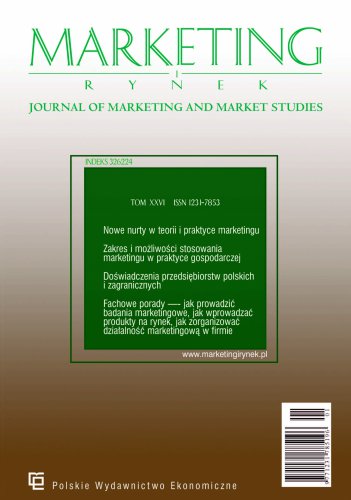The image of the national art museums among young audiences interested and not interested in art
The study aimed to compare the image of the national art museums in Poland among respondents studying art- -related and non-art-related faculties and to identify significant differences in the image of national museums among those two groups surveyed. The study was conducted using a questionnaire survey among a purposely selected group. To evaluate whether differences in the image of Polish national art museums between the described groups of respondents are statistically significant, Student t-tests for independent samples were done. Although significant differences were found between the study groups, they were not as significant as expected. Students of art-related courses better perceive the national art museums, but even in this group, the image of the studied institutions is rather neutral. Respondents from both groups associate national art museums in Poland primarily with education and school trips. National art museums do not appear to young audiences as friendly and egalitarian places; at the same time, respondents do not see them as elite or prestigious institutions. While this does not mean an image failure for the museums surveyed, they should make an effort to make young audiences find them more welcoming.
References
Barron, P., & Leask, A. (2017). Visitor engagement at museums: Generation Y and 'Lates' events at the National Museum of Scotland. Museum Management and Curatorship, 32(5), 473–490.
Batat, W. (2020). How can art museums develop new business opportunities? Exploring young visitors' experience. Young Consumers, 15.04.2020. https://doi.org/10.1108/YC-09-2019-1049
Bira, M., Zbuchea, A., & Romanelli, M. (2020). Romanian Museums under Scrutiny. Management Dynamics in the Knowledge Economy, 8(3), 297–320.
Blasco-Lopez, F., Recuero Virto, N., Aldas Manzano, J., & Cruz Delgado, D. (2019). Facebook's power: Factors influencing followers' visit intentions. Spanish Journal of Marketing – ESIC, 23(1), 95–117. https://doi.org/10.1108/SJME-06-2018-0032
Bronner, F., & de Hoog, R. (2019). Conspicuous leisure: The social visibility of cultural experiences. International Journal of Market Research, 147078531988071. https://doi.org/10.1177/1470785319880715
Burton, C., & Scott, C. (2003). Museums: Challenges for the 21st Century. International Journal of Arts Management, 5(2), 56–68.
Campbell, W. K., Campbell, S. M., Siedor, L. E., & Twenge, J. M. (2015). Generational differences are real and useful. Industrial and Organizational Psychology, 8(3), 324–331.
Cerquetti, M. (2016). More is better! Current issues and challenges for museum audience development: A literature review. Journal of Cultural Management & Policy, 6(1).
Chynoweth, A., Lynch, B., Petersen, K., & Smed, S. (2020). Museums and social change. Challenging the Unhelpful Museum. Routldege.
Cotter, K. N., Fekete, A., & Silvia, P. J. (2022). Why do people visit art museums? Examining visitor motivations and visit outcomes. Empirical Studies of the Arts, 40(2), 275–295. https://doi.org/10.1177/02762374211011740
Fronzetti Colladon, A., Grippa, F., & Innarella, R. (2020). Studying the association of online brand importance with museum visitors: An application of the semantic brand score. Tourism Management Perspectives, 33. https://doi.org/10.1016/j.tmp.2019.100588.
Gargiulo, R., Bifulco, F., & Russo Spena, T. (2021). Digital targeted communication: An integrated approach. In: T. Russo Spena, F. Bifulco (Eds), Digital transformation in the cultural heritage sector (199–219). Springer. https://doi.org/10.1007/978-3-030-63376-9_10
Gil, M. S., & Ritchie, J. R. B. (2009). Understanding the museum image formation process: A comparison of residents and tourists. Journal of Travel Research, 47(4), 480–493. https://doi.org/10.1177/0047287508326510
Gofman, A., Moskowitz, H. R., & Mets, T. (2011). Marketing museums and exhibitions: What drives the interest of young people. Journal of Hospitality Marketing & Management, 20(6), 601–618. https://doi.org/10.1080/19368623.2011.577696
GUS. (2018). Szkolnictwo wyższe w roku akademickim 2018/2019. Gdańsk.
Hughes, K., & Moscardo, G. (2017). Connecting with new audiences: Exploring the impact of mobile communication devices on the experiences of young adults in museums. Visitor Studies, 20(1), 33–55. https://doi.org/10.1080/10645578.2017.1297128
Hyun, H., Park, J., Ren, T., & Kim, H. (2018). The role of ambiances and aesthetics on millennials' museum visiting behavior. Arts and the Market, 8(2), 152–167. https://doi.org/10.1108/aam-04-2017-0006
Jureniene, V., & Peseckiene, D. (2020). Art gallery visitors' motivations. Information Sciences/Informacijos Mokslai, 89, 17–33. https://doi.org/10.15388/Im.2020.89.37
Macalik, J. (2020). Zintegrowana komunikacja marketingowa w działalności polskich muzeów. Wydawnictwo Uniwersytetu Ekonomicznego we Wrocławiu.
Manolika, M., & Baltzis, A. (2022). Concert hall, museum, cinema, and theater attendance: What difference do audience motivations and demographics make? Empirical Studies of the Arts, 40(1), 37–56. https://doi.org/10.1177/0276237420979569
McCall, V., & Gray, C.S. (2014). Museums and the 'new museology': Theory, practice and organisational change. Museum Management and Curatorship, 29, 19–35. https://doi.org/10.1080/09647775.2013.869852
Moreno-Gil, S., & Ritchie, J. R. B. (2017). Research based guidelines for effective visitation management of museums' image. International Journal of Culture, Tourism and Hospitality Research, 11(4), 534–550. https://doi.org/10.1108/ijcthr-01-2017-0007
Nguyen, V. H., Truong, T. X. D., Pham, H. T., Tran, D. T., & Nguyen, P. H. (2021). Travel intention to visit tourism destinations: A perspective of Generation Z in Vietnam. The Journal of Asian Finance, Economics, and Business, 8(2), 1043–1053.
Ostrowska, I., & Gracz, L. (2013). Młodzi nabywcy na e-zakupach. Agencja Wydawnicza Placet.
Ozuem, W., Willis, M., Howell, K., Lancaster, G., & Ng, R. (2021). Determinants of online brand communities' and millennials' characteristics: A social influence perspective. Psychology and Marketing, 38(5), 794–818. https://doi.org/10.1002/mar.2147
Skutnik, J. (2019). Młodzi dorośli w kulturze – casus muzeum. Cieszyński Almanach Pedagogiczny, 6, 90–127.
Śmiałowicz, K. (2019). Marketing communications of national art museums in Poland – barriers and opportunities for adopting a brand identity. In: N. R. Potoczek & A. Ujwary-Gil (Eds), Organizations in the face of growing competition in the market 2, (147–167). Instytut Nauk Ekonomicznych Polskiej Akademii Nauk.
Śmiałowicz, K. (2020). Online Marketing Communication of Polish National Art Museums in Comparison to Selected European Museums. Marketing Instytucji Naukowych i Badawczych, (3/37), 33–50.
Sobocińska, M. (2008). Zachowania nabywców na rynku dóbr i usług kultury. Polskie Wydawnictwo Ekonomiczne.
Szafraniec, K. (2011). Młodzi 2011. Kancelaria Premiera.
Tregua, M., López-Gúzman, T., & Bifulco, F. (2022). Museums in a changing context: Ten challenges for managers. In: F. Bifulco & M. Tregua (Eds), Handbook of research on museum management in the digital era (1–19). IGI Global. https://doi.org/10.4018/978-1-7998-9656-2
Willems, K., Brengman, M., & Van Kerrebroeck, H. (2019). The impact of representation media on customer engagement in tourism marketing among millennials. European Journal of Marketing, 53(9), 1988–2017. https://doi.org/10.1108/EJM-10-2017-0793

